By Douglas W. Cornwell —
Many times we have heard someone say, “in days gone by.” This past year, 2023 to 2024, is the Bicentennial year for Newark Valley. We are free to mention what has happened in Newark Valley in “days gone by?”
To summarize what has been written in earlier articles, the history 200 years ago went like this: the southern part of the town of Berkshire, now the town of Newark Valley, split from Berkshire on April 12, 1823. The new town board was elected and met for the first time on March 2, 1824, as the town of Westville. The town was renamed Newark on March 24, 1824.
Attempting to discover why the name of Westville was used has been like putting together a jigsaw puzzle. In the 1790s, Brown’s Settlement on today’s Brown Road was settled by pioneers from Stockbridge, Massachusetts, near the current town line between Newark Valley and Berkshire. The area now known as the village of Newark Valley was first settled by the Slosson and Lincoln families about 1792-93. Otis P. Lincoln arrived here from Warren, Massachusetts.
The puzzle about the name of Westville is speculation that Lincoln came from a town in Massachusetts once known as Western, Massachusetts before being renamed Warren. Most communities developed around a church. Church was very important to the early settlers. So Brown’s Settlement was where the “Society of the Western or Congregationalists,” founded a church in 1803. The first building is now located on Whig Street and within the village.
The second church building was erected at Brown’s Settlement in 1814, but moved to the current location of the church building within the village in 1832, about eight years after the town of Newark was created in 1824. During its early years the community revolved around the church, explaining why the church went with the community. With the church buildings moved numerous times, the church was once known as the “traveling sanctuary.”
The Lincoln and Slosson families, building homes in the area near the current village green, may have had a great deal of power within the community in getting that building moved to the present-day village in 1832, as they began developing the new village.
It was the Rev. Marcus Ford of the Congregational Church who suggested the name change from Westville to Newark. These examples and the fact that William Slosson Lincoln (1813-1893) was elected to Congress in 1866 hold a strong piece of the puzzle for how events happened in those “days gone by.” There may still be missing pieces to that puzzle, but perhaps this is progress in figuring out something we have known about the names of this town. (Additional note: today, there is a town of Westville, New York, located near Cooperstown, New York.)
To learn more about Congressperson William Slosson Lincoln, visit https://en.wikipedia.org/wiki/William_S._Lincoln. For there it explains how he had also served as postmaster, town supervisor, and town justice of the peace prior to departing for Congress.
One thing to add, his birth is listed as “… in Berkshire (now Newark Valley).” In a sense, this is an accurate statement; but one not familiar with this area might think that Berkshire no longer exists and is now named Newark Valley. Confusion often reigns, so it is necessary for there to be a town historian who can validate names and events.
By 1862 the town of Newark had to be renamed Newark Valley. So, you ask why do we have the name Newark Valley rather than simply Newark? The reason is the existence of two post offices in New York with the name of Newark. Besides this town in Tioga County, a town of Newark also exists in Wayne County, east of the Monroe County area (Rochester). In April 1862, as the American Civil War began to rage, Newark in Tioga County was renamed Newark Valley. So, we have that name today because of the valley where “Newark” of Tioga County was located.
If you have ever visited Newark in Wayne County you will discover it is very flat, and has few hills and valleys. So it is quite appropriate this town was named Newark Valley.
Here we are in April of 2024. The Newark Valley Bicentennial year is upon us. Looking positively towards the future, then 2024 is a year to celebrate 200 years of Newark Valley. We do this in anticipation for future years. A town and village which was formed by ingenuity and assertive thinking for the future. We now have an opportunity to view the history of what happened for us to arrive at this point in time.
The “days gone by” do not have to be looked at negatively, but to learn from the positive developments over the past 200 years.
Business and Commerce in Newark Valley has been very prominent over the past 200 years. The Kemp Company, a tannery, grist mill, sawmill, Northern Tioga Phone Company, the Tioga County Herald, the original electric generating in Newark Valley, plus many other business and commerce ventures developed in this community.
The former Town Historian, the late Ginnie Mullen, wrote in the Owego newspaper about a Byington clock, which is on display at the Hoffman Clock Museum (https://hoffmanclockmuseum.org/1/scenes/Home.htm?win=Main) in Newark (Wayne County), N.Y. The clock has an inscription about being “made in Newark, N.Y.”
That would have been Newark [Valley], Tioga County, not Wayne County. The clockmaker was Lawyer Byington (1779-1856). An example of a misprinted label on a clock is provided here with one of the Lawyer Byington clocks. With this Byington Clock example, we see names of towns are important for a number of different reasons.
There are songs with lyrics about “those were the good old days.” Such lyrics might make us think these days are not so good. We could learn from those “old days” and learn to live in anticipation about a better future.
The preferable song would be Carly Simon’s song, “Anticipation.” In that song, there are words that make more sense for those learning how history can help us to learn and to better prepare for the future. The words go, “These are the good old days.”
Perhaps the 2024 summer and the Newark Valley Historical Society Depot concerts can be part of the celebration of the Bicentennial? The schedule is out, so link to the Newark Valley Historical Society website at www.nvhistory.org for more information.
Perhaps another venue for the Bicentennial might be the Summer Fest in July? Pure speculation about what might be done. We welcome suggestions and comments.
This author may be contacted at bibsinger12@aol.com.
Information about books used in this article:
Mullen, Virginia H. (2008). An updated history of the village of Newark Valley, N.Y. 1792-2008. Newark Valley, N.Y. : The author.
Newark Valley Historical Society, compiler. (1976). The photo history of Newark Valley. Newark Valley, N.Y. : The authors and compilers
Purple, Gilbert E. Purple. (1937). As we remember the Village of Newark Valley. Newark Valley, N.Y.: Tioga County Herald Printing.





Be the first to comment on "Remembering Newark Valley 200 Years Ago; April 6, 2024"